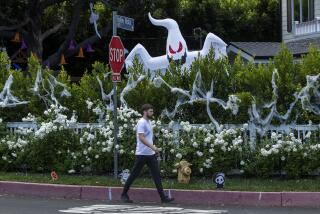Halloween Distortion : Sociologist Finds Perils of Trick-or-Treating Have Been Greatly Exaggerated
- Share via
Halloween, everyone knows, is the most dangerous holiday of the year. Reports abound of children dying after eating drug-laced candy and having their mouths slashed after biting into razor blades slipped into apples. But a new survey by a sociologist at California State University, Fresno, disputes those reports, saying in more than two decades there has not been a single death or a severe injury caused by Halloween sadists.
Reported incidents of tampering with Halloween treats are more often than not the results of tricks played by the “victims” themselves, the study said.
Writing in the November issue of Psychology Today, Joel Best, chairman of Cal State Fresno’s sociology department, said, “Children who go trick-or-treating know about Halloween sadism--they have been warned by their parents, teachers and friends. A child who ‘discovers’ an adulterated treat stands to be rewarded with the concerned attention of parents and, perhaps, police officers and reporters. And, of course, such hoaxes fit the tradition of Halloween tricker.”
Best and his researcher, Gerald T. Horiuchi, came to the conclusion that the holiday is not as dangerous as commonly believed after reviewing all stories about Halloween sadism in three major regional newspapers--the New York Times, the Chicago Tribune and the Los Angeles Times--as well as the Fresno Bee, from 1958 to 1984.
Stories in those papers, Best wrote, “described 76 specific incidents and alluded to hundreds more, yet a careful reading reveals no deaths or severe injuries caused by Halloween sadists.”
Two notorious cases in which the children died, for example, were found not to be related to anonymous pranksters, Best said. In one 1970 case, a 5-year-old boy died after eating heroin supposedly hidden in his Halloween candy, but follow-up reports revealed that he had found the heroin in his uncle’s home, not in his treats. In a 1974 case, an 8-year-old boy died after eating cyanide-laced candy, but it was his father who was later arrested for poisoning the treat.
“While our search may have overlooked authentic cases of death or serious injury caused by Halloween sadists, it is unlikely,” Best concluded.
The dangers associated with Halloween have been overblown and may well be the result of increased publicity about all types of crimes against children, including incest, child abuse and kidnaping, Best said.
Best’s conclusions mesh with the experience of Valley Presbyterian Hospital in Van Nuys, which has run a Halloween X-ray program for the past four years to screen trick-or-treat candy free of charge. Although the service will be continued this year, not a single piece of metal has been detected nor has the emergency room reported any unusual problems related to Halloween, Tim Bradley, a hospital spokesman, said Monday.
Similarly, Cmdr. William Booth of the Los Angeles Police Department said over the years the department has “responded to many reports of blades and needles in trick-or-treat goodies” but most of them have turned out to be inaccurate.
Booth cautioned, however, that there are things that should concern parents on Halloween. “There will be a lot of little hobgoblins and ghosts out. The No. 1 thing is not to run over them with automobiles as they dart across the street.”
What’s more, he said, parents should continue to scrutinize the candy their children collect on their trick-or-treating adventures. “But it is mostly for hygienic and health purposes that you should monitor what your little ghosts are consuming,” Booth said.
The Los Angeles County Sheriff’s Department does not gather statistics related to Halloween, a spokeswoman said.
More to Read
Sign up for Essential California
The most important California stories and recommendations in your inbox every morning.
You may occasionally receive promotional content from the Los Angeles Times.










